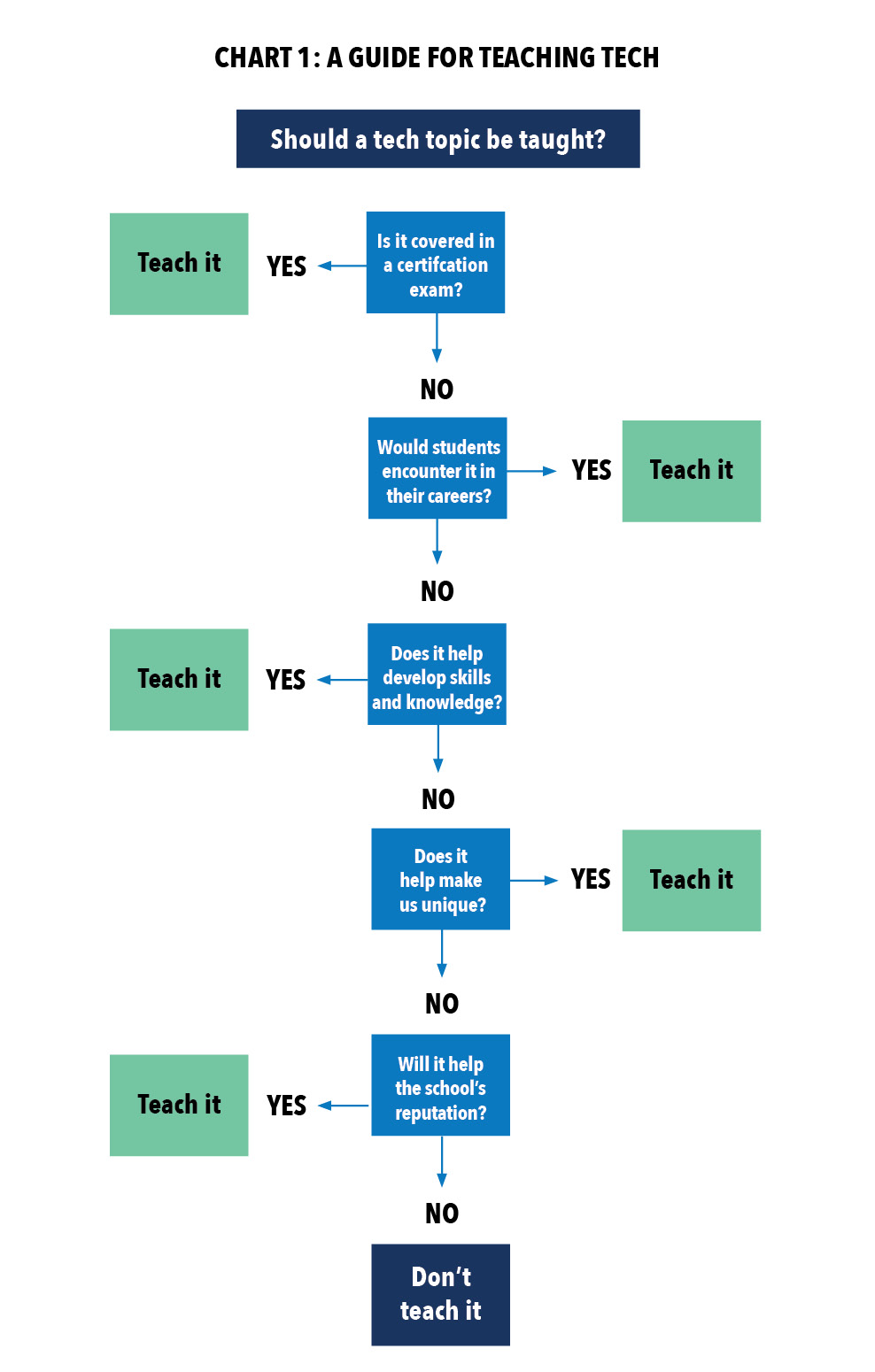Tech transformations are revolutionizing the business world—and the accounting and finance profession is increasingly leaning into new and existing tools. From cutting-edge innovations like AI and blockchain to essentials like Excel and programming tools, technology is now fundamental for any finance function.
But this creates a challenge for business schools educating the next generation of accounting and finance professionals. They must adapt their courses and curriculum so students enter the workforce with proper tech acumen. But what technology should they teach? And how do they make tech discussions relevant?
In some ways, this is not a new dynamic for accounting and finance educators. They’re accustomed to weighing what new topics should be added to an already-crowded curriculum. Many students seek out professional certification exams following their studies, like CPA, CMA® (Certified Management Accountant), or CFM® (Certified in Financial Management). In many cases, these exams dictate what’s included (and excluded) in course curriculum. And many accounting programs require students to have 150 credit hours of education before they can become CPAs. This is part of an effort to relieve some of the crowded undergraduate curriculum by offering some of the desired content as part of a graduate degree. In addition, professional exam requirements often lead faculty to tailor their teaching materials toward exam content.
On top of all that, accounting and finance students have limited time to learn and prepare for their future careers. Finding the right mix of subjects is about trade-offs, since any time spent teaching technology must be balanced with teaching more traditional topics such as ethics, financial statements analysis, or auditing. Some professionals argue that universities should focus on broad-based skills like writing, communication, and making presentations—capabilities students need to get a job—leaving employers to provide training that’s tailored for specific roles within their firm. But that mindset is shifting within our hypercompetitive job market. Many professions need employees so badly that there’s little time for on-the-job training. They need graduates to possess the proper knowledge and skill sets to be productive workers from day one.
When it comes to teaching tech, educators face myriad dilemmas. Should they teach what students want? What employers want? Focus on what’s foundationally important? With all these considerations, educators need a strategy for assessing which topics to incorporate into a finance and accounting curriculum. In an effort to help them determine whether to incorporate new topics and tools into the accounting and finance curriculum, we’ve developed a framework that’s summarized in Chart 1 and detailed in this article.
A Framework for Choosing What to Teach
When deciding whether to teach a new technology and, if so, how to incorporate it into their curriculum, instructors must weigh several considerations.
The questions posed in our framework help guide this discussion and steer educators toward possible answers. Of course, we realize that this framework will likely be modified in the future to consider contingencies and other unknowns. We also recognize that any framework needs to remain flexible so different faculty can reach different conclusions. The following questions are meant to provide a structured starting point for considering whether to teach (or not teach) new technology to finance and accounting students.
Will the technology be covered on a professional certification exam?
In many cases, certification exams drive curriculum. This is especially true in accounting (CPA and CMA® exams) and in finance (CFA exam). Although most educators do not teach for the exam, instructors want to ensure their students are prepared, meet the requirements to take the exam, and are comfortable enough with the material to pass the test. If a new topic or technology is covered in a certification exam, faculty should consider including that topic in their curriculum. One such example is the inclusion of data analytics and data visualization. If those topics are on a certification exam, and faculty teach the topics (as they likely should), the underlying technologies enabling the analysis or visualization might need to be covered, too.
Are the students likely to encounter this technology in their professional career?
While preparing students for professional careers, educators must assess whether the new technology in the curriculum will exist within their day-to-day work. That’s an easy decision for established technologies such as Excel, data visualization tools, or analysis software like Tableau and Power BI—all of which will likely be core to their professional responsibilities. The same could be true for emerging AI tools. As they become more prominent in finance and accounting roles, students should understand and be comfortable with this technology.
On the other hand, a technology like XBRL, a markup language used to tag financial statements of public companies filed with the SEC, might not be used as widely. Since most XBRL users would be in companies’ corporate reporting department, educators might limit XBRL to an accounting information system class, and even then devote little time to it.
Does the new technology help the development of desired skills?
Sometimes, introducing new technologies in the classroom isn’t the goal, but rather the means to achieve the goal. For example, let’s examine the ability to analyze data. Many schools have started teaching data analytics skills in response to new data analytics standards by AACSB and increased use of data analytics by professionals. Instructors might need to lean into tech to best teach students how to analyze data—not for the sake of learning the new technology, but as a means of teaching data analytics skills.
Following this logic, educators might need to introduce other technologies to facilitate the learning and development of desired skills. For example, can teaching critical-thinking skills be augmented through AI? A faculty member might want to assign students work using AI and have them review these assignments to apply critical thinking. Another example may be to teach students a programming language and use student programming assignments to enhance their problem-solving skills. This approach can yield some important benefits, like students showing greater interest in new tech and becoming more invested in the curriculum.
Also, new technologies can be used to teach basic accounting material. For example, when exploring fair value assets, the instructor can explain how to account for Bitcoin assets or liabilities. Finance faculty teaching forward contracts might explain what blockchain is—and how smart contracts can be used to create forward contracts. Instructors could also discuss blockchain in the context of counter-party risk and spell out the differences between centralized and decentralized exchanges. It’s important to recognize that the risk exposures are significantly different between the traditional financial system and the new financial landscape created by blockchain technology. In that sense, we’re not teaching blockchain for its own sake, but to help students better understand the risk and its impact.
At the very least, integrating new technologies into the curriculum is a way to help students understand that they’ll spend a career learning about new technologies. Students who know how to learn new skills and incorporate new technologies will be more adaptable and successful throughout their careers.
Will it help the school’s reputation?
Schools are always looking to stay relevant to attract students. One way to do that? Include new technologies in their curriculum. Maybe it’s through offering a cryptocurrency class or creating a workshop for students to issue tokens. Regardless of the course, the decision to teach new technologies is a way for a school or program to differentiate itself in the market and develop a reputation for being an innovator—a strategy that can appeal to prospective students and their parents. For example, universities can add minors in Big Data analytics, which generally includes extensive work with Python and use of APIs. And integrating AI into programs will be an imperative for years to come. Carnegie Mellon launched an AI program in 2018—four years sooner than MIT—and in fall 2024, the University of Pennsylvania will introduce a major in AI. Schools can attract students by teaching emerging technologies not yet offered at other institutions.
Redrawing the Tech Learning Curve
Deciding what technologies to teach our students isn’t easy—and in the face of constant innovation, those choices will remain a moving target for faculty. As a result, schools and instructors need to be prepared to constantly shift their curriculum to reflect emerging tech tools and topics. On top of that, faculty should teach students foundational topics that allow them to interact with future technologies.
Finding a comfort zone when interacting with technology isn’t just a useful skill—it’s core to becoming lifelong learners and sustaining a future-focused career.




